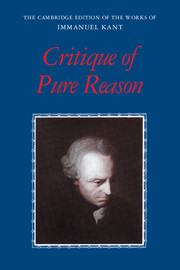Book contents
- Frontmatter
- Contents
- General editors' preface
- Acknowledgments
- Introduction
- Immanuel Kant, Critique of Pure Reason
- I Transcendental doctrine of elements
- Division two. Transcendental dialectic
- II Transcendental doctrine of method
- Chapter I The discipline of pure reason
- Chapter II The canon of pure reason
- Chapter III The architectonic of pure reason
- Chapter IV The history of pure reason
- Editorial Notes
- Glossary
- Index
Chapter III - The architectonic of pure reason
from II - Transcendental doctrine of method
Published online by Cambridge University Press: 05 July 2013
- Frontmatter
- Contents
- General editors' preface
- Acknowledgments
- Introduction
- Immanuel Kant, Critique of Pure Reason
- I Transcendental doctrine of elements
- Division two. Transcendental dialectic
- II Transcendental doctrine of method
- Chapter I The discipline of pure reason
- Chapter II The canon of pure reason
- Chapter III The architectonic of pure reason
- Chapter IV The history of pure reason
- Editorial Notes
- Glossary
- Index
Summary
By an architectonic I understand the art of systems. Since systematic unity is that which first makes ordinary cognition into science, i.e., makes a system out of a mere aggregate of it, architectonic is the doctrine of that which is scientific in our cognition in general, and therefore necessarily belongs to the doctrine of method.
Under the government of reason our cognitions cannot at all constitute a rhapsody but must constitute a system, in which alone they can support and advance its essential ends. I understand by a system, however, the unity of the manifold cognitions under one idea. This is the rational concept of the form of a whole, insofar as through this the domain of the manifold as well as the position of the parts with respect to each other is determined a prion. The scientific rational concept thus contains the end and the form of the whole that is congruent with it. The unity of the end, to which all parts are related and in the idea of which they are also related to each other, allows the absence of any part to be noticed in our knowledge of the rest, and there can be no contingent addition or undetermined magnitude of perfection that does not have its boundaries determined a priori. The whole is therefore articulated (articulatio) and not heaped together (coacervatio); it can, to be sure, grow internally (per intus susceptionem) but not externally (per ap-positionem), like an animal body, whose growth does not add a limb but rather makes each limb stronger and fitter for its end without any alteration of proportion.
- Type
- Chapter
- Information
- Critique of Pure Reason , pp. 691 - 701Publisher: Cambridge University PressPrint publication year: 1998
- 1
- Cited by



